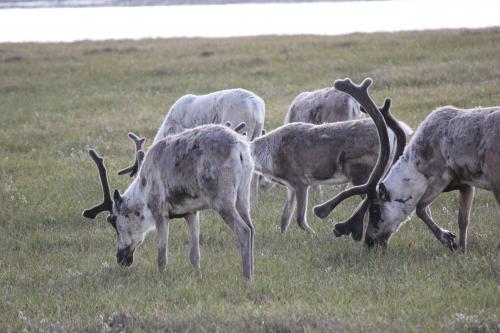Habitat Description
The Arctic Tundra is a very unique habitat with its own defining food web. I will be focusing on the Arctic tundra found in northern Alaska since that is where the Toolik Research Station is located. This biome has long cold dark winters and short cool summers with 24 hours of daylight. It has low precipitation and dry winds. The most unique part of the Arctic tundra biome is the permafrost or ground that is permanently frozen. Its frozen and no roots or water can get through. During the summer it starts to thaw on top and this is called an active layer. Within this layer, plant roots are now able to grow and insects can burrow into it.
Cool animation of this at USFWS http://www.fws.gov/refuge/arctic/activel.html#animation
Food Chains and Food Webs
Food chains are diagrams showing the energy transfer between different organisms in an ecosystem. Arrows point from the prey to the predator that will eat them.
Each food chain is one path that energy and nutrients may take as they move through the ecosystem. All of the interconnected and overlapping food chains in an ecosystem make up a food web.
Organisms in food webs are grouped into categories called trophic levels. Roughly speaking, these levels are divided into producers (first trophic level), consumers, and decomposers (last trophic level).
Producers
Producers make up the first trophic level. Producers, also known as autotrophs, make their own food and do not depend on any other organism for nutrition. Most autotrophs use a process called photosynthesis to create food (a nutrient called glucose) from sunlight, carbon dioxide, and water. The Arctic Tundra Food web producers include moss, sedge, grass, shrub, and lichen.
Consumers
The next trophic levels are made up of animals that eat producers. These organisms are called consumers.
Primary consumers are herbivores. Herbivores eat plants, algae, and other producers. They are at the second trophic level. The primary consumers in the Arctic Tundra Terrestrial Food web are caribou, pika, Arctic hare, musk ox and insects.
 A group of five caribou, eating tundra plants. North Slope, Alaska. Photo by Regina Brinker (PolarTREC 2014), Courtesy of ARCUS
A group of five caribou, eating tundra plants. North Slope, Alaska. Photo by Regina Brinker (PolarTREC 2014), Courtesy of ARCUS
Secondary consumers eat herbivores. They are at the third trophic level. Secondary consumers in the Arctic Tundra food web include fish, and grizzly bears (I’ve been told there are no polar bears at Toolik).
Tertiary consumers eat the secondary consumers. They are at the fourth trophic level. In the Arctic Tundra Food web, Arctic foxes, owls, Arctic Terns and wolves.
There may be more levels of consumers before a chain finally reaches its top predator. Top predators, also called apex predators, eat other consumers. There could be a fourth or fifth trophic level.
Detritivores and Decomposers
Detritivores and decomposers make up the last part of food chains. Detritivores are organisms that eat nonliving plant and animal remains.
Decomposers, like fungi and bacteria, complete the food chain. Decomposers turn organic wastes, such as decaying plants, into inorganic materials, such as nutrient-rich soil. They complete the cycle of life, returning nutrients to the soil. This starts a whole new series of food chains.
Source of Food Chain/ Food Web Info: http://education.nationalgeographic.org/encyclopedia/food-web/


Comments